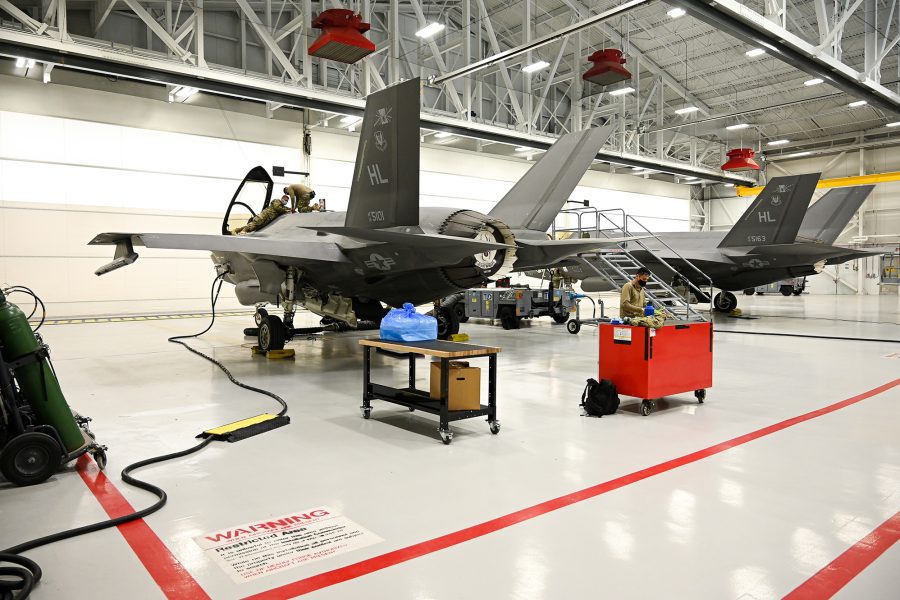The first production F-35 in an early version of the Tech Refresh 3 configuration has flown at Lockheed Martin’s Fort Worth, Texas, facilities, the company said. But while TR-3 testing continues, international F-35 partners are considering whether to accept jets with an immature version of the upgrade, government officials said.
Meanwhile, negotiations between Lockheed and the Joint Program Office on a contract for F-35 production lots 17-19 are still ongoing—but talks have broken down on a long-term Performance-Based Logistics contract that was expected to be inked this year. A shorter-term deal is being worked out.
Lockheed is now building TR-3-configured F-35s at Fort Worth, and the first one flew the week of Nov. 13, a company spokesperson said. The flight is part of the normal checkout process after one of the fighters comes out of the production plant. However, until formal testing of the TR-3 configuration is complete—now underway at Edwards Air Force Base, Calif. and Naval Air Station Patuxent River, Md. and —Lockheed must store the newly-built F-35s.
Final acceptance flights, before the government takes ownership of the fighters, will begin on the newly-configured jet “when the software is approved for operational use,” a JPO spokesperson said.
More than 150 test flights with the TR-3 have been made, a Lockheed spokesperson said.
The TR-3 is largely a processor upgrade; the prerequisite for the Block 4 capability upgrade of the F-35, which comprises more than 80 improvements to its electronic warfare systems and weapons portfolio, displays, and other systems.
The JPO and Lockheed are working with the services and the international partners to see if they could “potentially” accept TR-3 aircraft in an early version that would be “operationally acceptable,” a JPO spokesperson said. This approach would “most likely require future software drops” en route to delivering capability that meets all requirements, he said. No such decision has been made yet, though, and pending such a decision, Lockheed will have to store the jets.
Lt. Gen. Michael Schmidt, the JPO director and F-35 program executive officer, said in September that he expected the TR-3 upgrade testing to be complete in early 2024.
Negotiations on F-35 production Lots 18-19 are still underway, according to Lockheed. A spokesperson said “we are actively engaged” with the JPO to deliver a “cost-competitive” fighter. Schmidt said in September that there is no time limit by which those discussions have to conclude, and he would not predict when the JPO and Lockheed would reach a “handshake” agreement. Schmidt said a host of items are under discussion, such as inflation, labor shortages and costs, and other issues.
Lockheed officials have predicted the next lots will not continue the downward trend in prices due to economic factors and supply chain issues.
Schmidt has said the Pentagon “has a budget, and we can only afford what we can negotiate.”
While Lots 18 and 19 will be contracted together, Lot 20 is potentially the first lot that can be bought as part of a multiyear deal, which groups lots together to take advantage of economic ordering of parts and materials. A multiyear deal can only happen, though, after the program passes Milestone C, which is the full-rate production decision.
That, in turn, is dependent on competition of Initial Operational Test and Evaluation, which has been held up for several years while the F-35 has been integrated with the Joint Simulation Environment; a wargaming tool that helps requirers find the right balance of aircraft and weapons for given wartime contingencies.
The negotiations on new lots is independent of negotiations on a new support contract for the F-35, and those talks have been halted for the time being.
Lockheed has been pushing a Performance-Based Logistics Contract approach to F-35 maintenance for a number of years, but the Pentagon and Congress have balked, wanting to see better and faster improvement in F-35 operating costs. A five-year PBL would give Lockheed both more responsibility and more predictability in ordering and managing parts, providing service materiel, and managing the global F-35 fleet. The arrangement would tie payments to long-term performance. The existing deal is a “pay as you go” arrangement, a government official said.
The 2022 National Defense Authorization Act mandates that the Secretary of Defense certify that a PBL “will reduce sustainment costs or increase readiness performance,” a DOD official said.
“Currently, the proposed PBL does not meet the certification requirements,” the official said. “The F-35 Joint Program Office and Lockheed Martin have agreed to extend” the existing 2023 sustainment contract through March of 2024 “and are working an additional extension through June 2024.”
The extension ensures “there will be no breaks in contractual coverage, while also providing more time for the JPO and [Lockheed Martin] to plan and negotiate long-term contractual coverage.”
A Lockheed spokesperson said the company is “focused on partnering to determine an alternate contract solution in lieu of the PBL to go into effect July 1, 2024.”
“We continue to view [PBL] contracting as the primary way to increase part availability, readiness, and affordability for the long-term as the F-35 fleet scales,” the spokesperson said.
While it is “disappointed” with the decision not to make a PBL agreement and halt talks for now, “we remain committed to partnering with our customers to deliver sustainment support, enabling mission readiness and deterrence,” the Lockheed spokesperson added, noting that PBLs are “a recognized best practice” of the Pentagon and have been used “successfully on many large-scale sustainment programs,” such as the F-22, MH-60, HIMARS and others.
